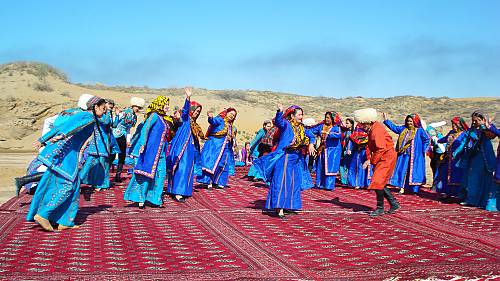 |
| Dutar |
There are several instruments that are uniquely Turkmen from a cultural standpoint. The dutar plays an important part in Turkmen music and can be used to play several styles of music. It’s generally strummed or plucked. It originally had strings made of catgut, which switched over to silk as the Silk Road stretched its way through the land, and that eventually gave way to nylon strings in modern times. The tuiduk is similar to the zurna as a type of woodwind instrument blown through the end. It’s also the object of legend: some say that the tuiduk is what gave Adam his soul when played by the angel Gabriel (brass players know that woodwood instruments actually steal your soul, not the other way around. I’m joking, for crying out loud.). However, another legend says that the tuiduk was played by the devil (this might be true) (Again, I’m joking. Don’t send me hate mail.) A related instrument is the dili tuiduk, which is a single-reed instrument that’s more like a clarinet. The gargy tuiduk is another end-blown flute that’s like the ney.
While different ethnic groups have their own dances and variations, one dance tradition that made UNESCO’s Intangible Cultural Heritage list is Kushtdepdi. This performance art of singing and dancing is centered around giving good feelings and well wishes. Basically, any time there’s a celebration or national festival, kushtdepdi is performed. Master singers pass these skills down to amateurs, and it’s seen as a bridge between the generations. I also came across an older article about how everyone in the country was getting ready for their Independence Day celebrations by having the entire country learn a dance. And by learning, I mean, they had government-led mandatory 3-hour dance lessons held in stadiums. Schools would end early so they can learn this dance in the afternoons, just in time for all the office workers to take their lessons in the evenings. I guess, I suppose that could be fun.
 |
| "Elini Ber" |
I came across a few Turkmen musicians. There weren’t very many on Spotify, although there may be more on YouTube somewhere. The first one I listened to was a song called “Elini Ber” by Parahat Amandurdyyev and Mahri Pirgulyyeva. It’s kind of a dance-pop song, very European in style.
 |
| Firyuza |
Next I listened to a couple songs by Firyuza: “Boom Boom” and “Soyguni ber.” Her songs were in the same dance-pop category. I thought it was kind of catchy. She almost makes use of some R&B styles as well.
 |
| Narzes |
I found a hip-hop artist called Narzes. I was kind of impressed that it was better than I expected. The songs definitely were different enough from each other, and his flow and cadence were good. And there were times when he threw in some English words too.
Last but not least, I found a death metal band from Turkmenistan called Shovel on the Corpse. I’m not typically a death metal fan (I prefer other genres of metal), but at least they are representing their country. I’m sure it’s probably difficult to play and sing that way. And I’m sure it’s a cathartic release of energy for them.
Up next: the food


No comments:
Post a Comment